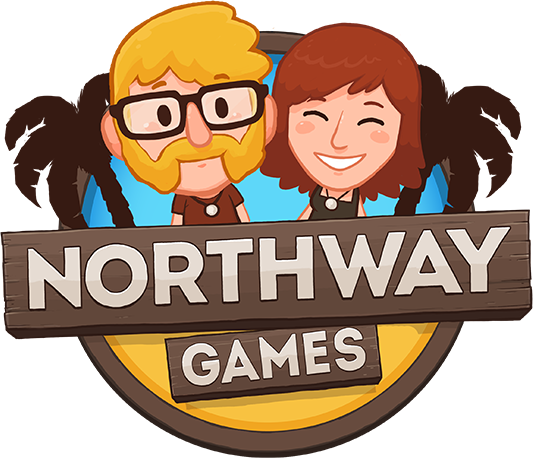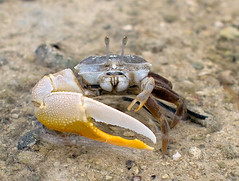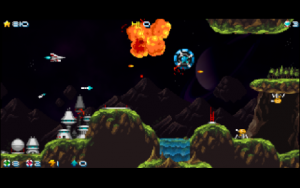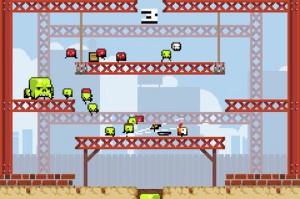
I haven’t written much for a while because as soon as we got to San Francisco we got crazy busy. We have so many friends here it’s hard to find the time for things like blog posts. I’m having enough trouble finding the time to do development.
I also haven’t taken any pictures apropos to this topic so I’m just going to pepper it with random snaps from our time in SF. This blog is also about travel after all. Anyway, one advantage of having so many people around is that I can run experiments on them.
I’ve been interested in problem solving for quite a while. Specifically, the difference between just sitting down and thinking out a problem versus playing around with it and trying to tease a solution out. To get a feel for how good we are at just thinking something out I devised an experiment and tested some fellow indies.
Sarah and I work during the day at a workspace we share with some other SF indie game makers. It’s nice to be surrounded by peers and their good ideas and it’s also a convenient space to hang ropes. Lately I’ve been hanging ropes from the light fixtures and proposing a challenge to everyone in the office. I’ll propose it to you now and you can see what you think.

The setup is simple. There are two ropes that hang from the ceiling. One rope has a loop in the end, and one rope has a knot. Your goal is to put knot through the loop. The ropes are easily long enough to accomplish this but they aren’t so long that you can grab one and then walk over and grab the other. If you tried to do so you would find your outstretched arm about a meter away from the limp second rope.
Now find 4 ways to put the knot through the loop. You can use anything you might find in a typical office. You can not cut the ropes or untie any knots. Give this a few moments thought, you are in a perfect position to be part of the experiment.
When I do this in the office I let half of my subjects play with the ropes to find solutions. The other half can merely look at the ropes and propose solutions. You are in the second category and I imagine that your performance will not be as strong as the people in the first category (especially since you have to imagine the whole setup).
Alright, are you comfortable with the solutions in your head? I’m going to give you the four intended solutions:
- Take a chair, put it in the middle of the room, place one rope on the chair while you fetch the second rope.
- Find an Ethernet cable or something rope-like to tie to the first rope. Use this to make the first rope longer so that you can reach the second rope.
- Find a long tube or a stick. Grab the first rope and walk as far towards the second rope as possible, then use the stick to reach the second rope.
Now here comes the important one. The first three are all pretty easy to find. If you were in the room you would have come up with them all. This next one is the one I’m interested in because people tend not to find it if they aren’t actually playing with the ropes.
- Tie something heavy to the end of the first rope and give it a big swing. Then run to the second rope and back in time to catch the swinging first rope.

If you thought of the swinging solution then well done. If you thought of it in less than ten minutes then really well done. You are in the vast minority of people I tested. Most people had a lot of trouble finding the swinging solution unless they got to play with the ropes. Conversely, people who did play with the ropes often found it fairly easily. This is because the rope with the knot on it swings a little bit on its own.
People who got to play with the ropes would usually find the chair solution first (actually there’s a couch in the right place so people tended to just use the couch). But after finding the chair solution they would drop the ropes and the rope with the knot would swing a little bit. They didn’t always notice it. Sometimes they were looking elsewhere, but by the time they found the three easy solutions it was almost inevitable that they would see the rope swing and that would give them the idea for the fourth solution.
This is important because I think we tend to be overconfident in our ability to imagine solutions to problems and imagine how ideas will play out. As a game designer I am very guilty of this. I will discount ideas because I can’t imagine them being cool. The problem is that we aren’t as good at this as we think. Natural human problem solving relies on playing around with things. We shake things and pull at them, we hit things and try to mush things together. When we play we’re looking for novel behaviour. We’re looking for cracks in the problem that we can exploit and make wider. We can do this in our minds as well but we’ll never be able to find a truly surprising solution unless we’re in the room playing with the ropes.

This means I should be prototyping more. I should stop discounting ideas because I can’t imagine them working. I should sink an afternoon into hacking them out. I might waste a few afternoons at this but it’s also the only way I’ll find unexpected wins.
It also means we should just hurl ourselves into those huge, daunting, problems that are so intimidating (like Spacechem). They are daunting because we can’t imagine all the moving pieces but we don’t have to. We can just play around and let the solutions make themselves known. It’s how kids solve every problem, I think we’ve just gotten lazy.













